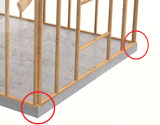One thing that often surprises me about firearms instructors is how much we take for granted. This little business of a “safe direction,” for example. We often teach our students to chant the rule (“Always keep the gun pointed in a safe direction,” as the NRA puts it) … without defining what a safe direction really is.
For those who don’t already know this, a safe direction is
- somewhere that, if shot, would cause only minimal, acceptable property damage; and
- somewhere that you can absolutely, positively guarantee the bullet won’t keep going after it lands there.
That’s a rather dry definition, but it covers the bases well enough. Unfortunately, many students need these concepts fleshed out a bit more. When presenting this idea, I like to ask my students, “Okay, that’s the basic idea. Everyone, right now, point to the safest direction in this classroom.” Some point without hesitation, and of those, many get it wrong. Others dither, or sit on their hands looking perplexed. That provides us with an excellent opportunity to discuss things that do, or do not, stop bullets.
Unless built of brick or stone, interior and exterior walls do not reliably stop bullets. Bullets zip right through sheetrock and paneling. Insulation barely slows them down. Windows simply shatter. Exterior siding rarely stops them. This means you cannot simply point at an apparently-solid wall and call it a “safe direction.” Yet many people do just that, instinctively thinking of a wall as something that would be safe to point the gun at, so we need to make sure our students understand these factors very clearly.
But what does that leave us with? Are we completely unable to handle our firearms as long as we are inside a building? Not quite, but it’s important to understand what we’re doing and why.
Of course, in your own home you can and should make a safe backstop that you can trust. But it’s a little different when traveling. When you’re on the road, you have to be a little more thoughtful and creative. (Unless you choose to travel with a — recommended! — Safe Direction ballistic containment product of your own.)
On the ground floor of a building, you can usually point the gun at the floor without too much risk. This does not work if you have a basement level underneath you, and of course it does not work if you’re standing on the second floor. Keep in mind, however, that a discharge straight into the floor may send a ricochet straight back up. You’re much safer with the gun pointed at a downward angle of 45 degrees or so — say two feet in front of you — than you are with it pointed straight down.
Some people want to point the gun at the ceiling. This is a very bad idea if you’re on the ground floor of a multi-story building, and almost as bad if you’re on the top level with nothing above you but roof. Roofs and second-story floors do not stop bullets any more reliably than walls do. A certain number of people are killed by falling bullets every year.[ref]Yes, I’ve seen the Mythbusters episode. I’ve also seen the obituaries.[/ref]
So what’s the solution? What if you’re in a hotel room, on the second or third floor of a multi-story building, surrounded by other rooms that almost certainly have people in them? Is there a safe direction? How can you safely handle your firearm if you must?
If you have a need to handle your firearm in an environment like that, here’s my advice: visualize yanking all the sheet rock off the walls, so you’re looking at just the bare skeleton of the building around you. You can see 2×4’s every few feet along all the walls. Those might stop bullets, but there’s no way to know exactly where they are with the sheet rock and paint in place.
However, still looking at the skeleton of the building, you know that major support beams always come together along the floor at the outer corners of the room. You don’t have to see through walls to know where the outer corners of the room are, or to spot the location where both walls come together and meet the floor. So your safe(r) direction in that environment would be the corner of the floor of the room along an outside wall. Since support beams come together where the corners of the room come together, the corner of the floor on an outside wall is your best bet for hitting a support beam instead of a blank stretch of sheet rock. That makes it your safest direction in that environment.






14 Responses to Safe direction